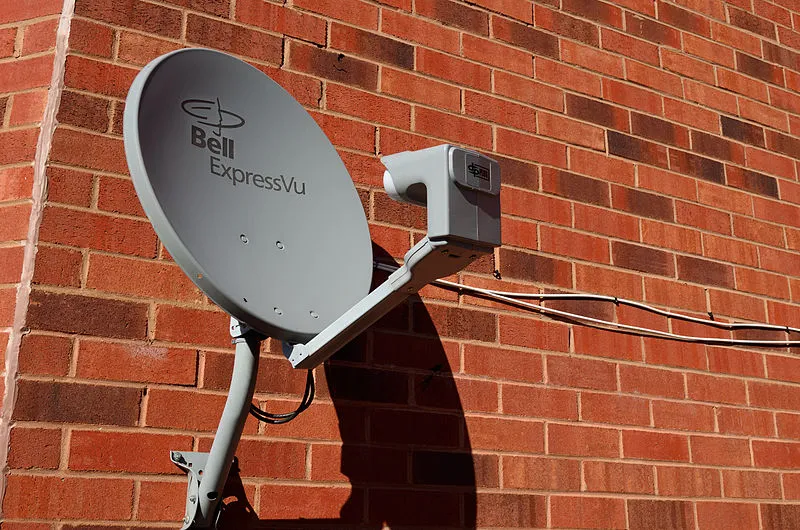Image Credit: wikimedia.org
As more people in the UK embrace the concept of tiny homes, it becomes essential to adapt regular domestic installations to fit these compact spaces. Receiving a reliable television signal remains a significant consideration. Installing a TV aerial in a tiny home can be different from standard-sized homes due to limited space and potential interference from surrounding structures. This guide provides a comprehensive approach to installing a TV aerial specifically tailored to tiny homes.
Understanding the Basics of TV Aerials
Before embarking on the installation, it’s crucial to grasp what TV aerials are and how they function. TV aerials, or antennas, are devices that receive broadcast television signals. These signals are transmitted in electromagnetic waves from broadcast towers and are captured by the aerial, then converted into the images and sounds on your TV.
For tiny homes, choosing the appropriate type of aerial is essential since space is limited and the aesthetic is often a priority. There are mainly three types of TV aerials suitable for different needs and circumstances: outdoor aerials, indoor aerials, and loft aerials.
Choosing the Right Type of Aerial for Your Tiny Home
Outdoor Aerials
Outdoor aerials are typically installed on a rooftop or an external wall. They generally provide the best reception because they have a clear line of sight to the transmitters. However, in the context of a tiny home, an outdoor aerial might be overkill unless the home is situated in an area with weak signal strength. The aesthetic impact and installation complexity are also considerations.
Indoor Aerials
Indoor aerials are compact and can be placed near windows or high up on the walls inside the tiny home. They are ideal for areas with strong signal reception and are easy to install. The main downside is that their performance may be inconsistent, particularly in areas where the signal strength fluctuates or where there is substantial electronic interference.
Loft Aerials
Loft aerials sit somewhere between the two. They are placed in the loft space and thus remain hidden from view while providing a stronger signal than an indoor aerial in many situations. However, lofts in tiny homes might be smaller or non-existent, making this option less feasible.
Assessing Signal Strength and Positioning
Checking Signal Strength
To determine which type of aerial will work best, start by checking the signal strength in the area where the tiny home is located. This can be done using online tools or mobile apps which show the availability and strength of TV broadcast signals. Local aerial installers can often provide insights as well.
Optimal Positioning
Correct placement of the aerial is crucial to ensure good reception. For outdoor aerials, higher positions are typically better. Indoor aerials should be placed near windows or on higher shelves. Avoid placing them behind the TV or in enclosed spaces where signals might be blocked. For loft aerials, avoid placing them near metal objects or large surfaces that might reflect or block the signals.
Preparing for Installation
Tools and Equipment Needed
Before beginning the installation, gather all necessary tools and components. Essential items include:
- TV aerial
- Coaxial cable
- Coaxial connectors
- Signal booster (if required)
- Mounting hardware (for outdoor aerials)
- Cable clips
- Ladder (for outdoor and loft installations)
- Drill and appropriate drill bits
- Screwdriver set
Safety Considerations
Safety cannot be overemphasised, especially when installing outdoor aerials. Ensure the ladder is stable and positioned on a flat surface. If climbing onto the roof, wear appropriate safety gear, including a harness if necessary. Avoid installation during adverse weather conditions, such as rain or high winds.
Installation Process for Outdoor Aerials
Mounting the Aerial
Begin by assembling the aerial according to the manufacturer’s instructions. Attach the aerial to the mounting pole, facing the general direction of the transmitter. Secure the mounting pole to the side of the house or the roof, ensuring it’s stable and properly anchored.
Running the Cable
Run the coaxial cable from the aerial to the inside of the tiny home. This may require drilling a hole in an exterior wall. Ensure the cable is secured along the route using cable clips to prevent damage.
Connecting to the TV
Inside the home, connect the coaxial cable to a signal booster if required, and then to the TV. Modern TVs have a built-in digital tuner, but if your TV is older, you may need an external digital tuner.
Installation Process for Indoor Aerials
Placing the Aerial
Identify the best location within the tiny home. This is typically near a window and away from large metal objects or electronic devices that might cause interference.
Connecting the Aerial
Attach the coaxial cable to the aerial and then to the TV or digital tuner. Some indoor aerials come with signal boosters that you can plug directly into the aerial socket.
Testing the Reception
Turn on the TV and go to the setup menu to scan for channels. Adjust the position of the aerial as needed to receive the best signal. You may have to move it slightly and rescan several times to get optimal results.
Installation Process for Loft Aerials
Positioning the Aerial
In a tiny home with a loft, find a suitable location to mount the aerial. This should be as high as possible and free from obstructions.
Running the Cable
Similar to the outdoor installation, run the coaxial cable from the aerial to the TV, using cable clips to secure it along the way.
Connecting and Testing
Connect the cable to a signal booster if necessary, and then to the TV or a digital tuner. Perform a channel scan and adjust the aerial position as required for optimal reception.
Troubleshooting Common Issues
Even after installation, you may encounter signal issues. Common problems include pixelation, loss of signal during certain times of the day, or no signal at all. These issues can often be resolved by:
- Repositioning the aerial
- Ensuring all connections are secure
- Using a signal booster if you haven’t already
- Checking for any sources of interference such as other electronic devices
In some cases, professional help might be required, especially if the underlying issue is beyond your expertise, like a damaged aerial or coaxial cable.
Why Hiring a Professional Aerial Installer is Recommended
Although installing a TV aerial may seem straightforward, there are numerous factors that could complicate the process. Professional aerial installers have the experience, tools, and knowledge to ensure the aerial is positioned correctly for optimal reception. They can also offer advice on the best type of aerial for your location and handle any unexpected complications that might arise during installation.
Conclusion
Installing a TV aerial in a tiny home requires careful consideration of space, signal strength, and aesthetics. By understanding the different types of aerials, checking the signal strength, and choosing the right tools and equipment, you can successfully install an aerial to enjoy a reliable TV reception. While do-it-yourself installations are possible, hiring a professional can save time, ensure the best reception quality, and provide peace of mind.
Also Read: How to Watch Restricted Videos on YouTube







